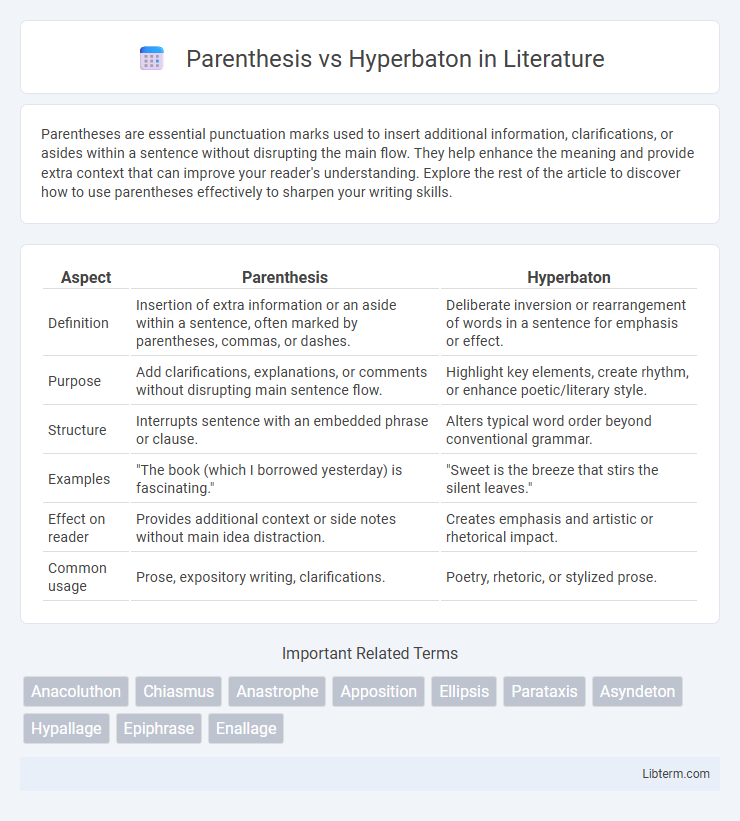Parentheses are essential punctuation marks used to insert additional information, clarifications, or asides within a sentence without disrupting the main flow. They help enhance the meaning and provide extra context that can improve your reader's understanding. Explore the rest of the article to discover how to use parentheses effectively to sharpen your writing skills.
Table of Comparison
| Aspect | Parenthesis | Hyperbaton |
|---|---|---|
| Definition | Insertion of extra information or an aside within a sentence, often marked by parentheses, commas, or dashes. | Deliberate inversion or rearrangement of words in a sentence for emphasis or effect. |
| Purpose | Add clarifications, explanations, or comments without disrupting main sentence flow. | Highlight key elements, create rhythm, or enhance poetic/literary style. |
| Structure | Interrupts sentence with an embedded phrase or clause. | Alters typical word order beyond conventional grammar. |
| Examples | "The book (which I borrowed yesterday) is fascinating." | "Sweet is the breeze that stirs the silent leaves." |
| Effect on reader | Provides additional context or side notes without main idea distraction. | Creates emphasis and artistic or rhetorical impact. |
| Common usage | Prose, expository writing, clarifications. | Poetry, rhetoric, or stylized prose. |
Introduction to Parenthesis and Hyperbaton
Parenthesis involves inserting clarifying or explanatory information within a sentence using punctuation marks like commas, dashes, or parentheses, enhancing the sentence's depth without altering its core meaning. Hyperbaton, a rhetorical device, disrupts the conventional word order to create emphasis or rhythmic effect, often placing adjectives after nouns or splitting related words. Both techniques enrich language by adding stylistic variation and highlighting key information.
Defining Parenthesis: Structure and Purpose
Parenthesis is a grammatical structure that inserts additional information or clarification within a sentence, usually set off by commas, parentheses, or dashes, without altering the main sentence's core meaning. Its purpose is to provide extra detail, explanation, or an aside that enhances the reader's understanding without interrupting the flow of the primary narrative. Unlike hyperbaton, which involves the deliberate rearrangement of word order for emphasis or stylistic effect, parenthesis maintains the sentence's logical sequence while embedding supplementary content.
Understanding Hyperbaton: Forms and Functions
Hyperbaton is a rhetorical device involving the deliberate rearrangement of word order to create emphasis or enhance poetic effect, differing from parenthesis which inserts additional information within a sentence. Common forms of hyperbaton include anastrophe, where the adjective follows the noun, and tmesis, which separates parts of compound words. Functions of hyperbaton range from emphasizing key concepts to inducing rhythmic variation, making it a powerful tool in both classical and modern literary contexts.
Grammatical Differences Between Parenthesis and Hyperbaton
Parenthesis involves the insertion of a clarifying or explanatory phrase within a sentence, often marked by commas, parentheses, or dashes, and does not alter the standard word order. Hyperbaton, on the other hand, is a rhetorical device that deliberately disrupts the conventional syntactic order of words to create emphasis or stylistic effect. Unlike parenthesis, hyperbaton manipulates word sequence, affecting grammatical cohesion without necessarily providing additional information.
Effects on Sentence Clarity and Emphasis
Parenthesis introduces additional information or clarifications within a sentence, often enclosed by commas, dashes, or parentheses, which can momentarily interrupt the flow but enhance understanding by adding context or detail. Hyperbaton disrupts the conventional word order to place emphasis on particular words or ideas, thereby heightening dramatic effect or focus, though it risks confusing readers if overly complex. The clarity of sentences is generally better preserved with parenthesis, while hyperbaton excels in emphasizing key elements at the potential cost of immediate comprehension.
Historical Usage in Classical Literature
Parenthesis and hyperbaton are rhetorical devices extensively used in classical literature to enhance emphasis and stylistic expression. Parenthesis involves the insertion of explanatory or qualifying material within a sentence, exemplified in Cicero's speeches where asides clarify arguments without breaking narrative flow. Hyperbaton, notably prevalent in Homeric epics, rearranges conventional word order to maintain metrical patterns and highlight particular concepts, as seen in the Iliad and Odyssey's rich poetic structure.
Modern Applications in Writing and Rhetoric
Parenthesis and hyperbaton serve distinct rhetorical purposes in modern writing, where parenthesis provides supplementary information through interruptions like commas or dashes, enhancing clarity and adding nuance. Hyperbaton disrupts conventional word order to emphasize particular words or ideas, commonly seen in poetry, advertising, and persuasive speeches for dramatic effect. Contemporary authors and marketers utilize parenthesis to maintain reader flow while embedding clarifications, whereas hyperbaton attracts attention and creates memorability by breaking syntactic expectations.
Common Mistakes and How to Avoid Them
Common mistakes with parenthesis include overusing them, leading to fragmented sentences and confusing the reader about the main point, while hyperbaton errors often involve disrupting natural word order excessively, resulting in awkward or unclear phrases. To avoid these issues, use parenthesis sparingly to insert supplementary information without interrupting the sentence flow and apply hyperbaton only when it enhances emphasis or style without sacrificing clarity. Careful proofreading and reading aloud can help ensure that both parenthesis and hyperbaton maintain coherence and improve readability.
Parenthesis vs Hyperbaton: When to Use Each
Parenthesis involves inserting additional information or commentary within a sentence, typically enclosed by commas, dashes, or parentheses, to provide clarity or nuance without disrupting the main thought. Hyperbaton rearranges the typical word order for emphasis or poetic effect, often creating a striking or memorable phrase by separating related words. Use parenthesis when adding supplementary or explanatory details, and choose hyperbaton to highlight specific elements by altering conventional syntax for stylistic impact.
Conclusion: Enhancing Expression Through Syntax Choices
Parenthesis and hyperbaton serve distinct roles in enhancing expression through syntax choices, with parenthesis providing supplementary information that clarifies or emphasizes without disrupting the main sentence flow. Hyperbaton, by altering conventional word order, introduces emphasis and rhetorical effect that captures the reader's attention and adds stylistic nuance. Mastering these devices deepens linguistic precision and enriches the expressive potential of writing by strategically manipulating sentence structure.
Parenthesis Infographic

 libterm.com
libterm.com